Gonatus middendorffi
Tsunemi KuboderaGonatus middendorffi: Holotype, 225 mm ML, collected at 45-30' N, 151-40' E, in the western North Pacific, on 29 August, 1976. Drawing from Kubodera and Okutani (1981).
Introduction
Gonatus middendorffi was described by Kubodera and Okutani (1981) based on a holotype (225 mm ML) and two male paratypes (183, 245 mm DML) with three additional juvenile specimens (40-60 mm ML) collected from the subarctic waters of the northwestern North Pacific. Morphological changes with growth of this species were well described. G. middendorffi is one of a few gonatids that can be identified almost throughout its life.
Nesis (1973, 1997) treated G. middendorffi as a synonym of G. kamtschaticus described by Middendorff in 1849. Based on the original description (Onych. Kamtschatica n. sp. in Middendorff's paper), G. kamtschaticus (24-26 cm ML) has a slender mantle, short fins about 1/3 of body length, long tentacles equal to body length, and the large central club hook is 8mm in length with a distal hook of 4 mm in length.
G. middendorffi specimens of nearly the same size as G. kamtschaticus have relatively larger fins (FL=1/2 ML), shorter tentacles and smaller clubs with much smaller central (ca. 4 mm) and distal hooks (ca. 2mm) on manus than G. kamtschaticus. We consider that G. middendorffi is not synonymous with G. kamtschaticus.
Diagnosis
A Gonatus with ...
- long slender muscular mantle (MW=18% of ML); small fins (FL=1/2 ML), sagittate with round sides (FW=77% of FL) and long tail (ca. 18% of ML).
- relatively short arms (AL<1/2 ML), short tentacles and small tentacular club (ca. 12% of ML).
- central large hook on tentacular club, medium-sized hook distal to central hook and five small suckers some of which are modified into small hooks in a line proximal to the central hook.
Characteristics
- Arms
- Arms relatively short and thick, muscular.
- Arm III longest (50% ML), arm I or IV shortest (87% of arm III).
- Arm III with aboral keel and IV with thin lateral keel along their entire lengths.
- Number of hooks and suckers on arm III 46-47 and 52, respectively.
- Tentacles
- Tentacles short, about 1/2 length of ML, slenderer than arms.
- Tentacular club remarkably small. about 1/10 of ML.
- Club with large central hook and medium sized hook distal to it.
- Proximal to large central hook, 5-6 small suckers continue longitudinally.
- Suckers of dorsal- and ventral marginal zones of club merge proximally.
- Head
- Head almost squarish in shape, slightly narrower than mantle opening.
- Funnel cartilage lanceolate in shape, nuchal cartilage rectangular with three grooves.
- Dorsal funnel organ inverted V-shaped, ventral ones large, oval in shape.
- Beaks. Information on the beaks of G. middendorffi can be found here.
- Radula composed of 5 rows of teeth.
- Fins and tail
- Fins sagittagte, fin length =1/2 ML, fin width=77% FL.
- Tail long, about 15-16% of ML.
- Photophores
- Photophores absent.
Comments
More details of the description of G. middendorffi can be found here.
We recently found several large Gonatus from stomach contents of a sperm whale caught in the western North Pacific that have a slender mantle with very small fins and a very large central hook with a medium sized distal hook on the manus. Specific characters and localities of the present specimens mostly agree with those of G. kamtschaticus. Although some parts of the squids were damaged by digestion, we are preparing to redescribe G. kamtschaticus in detail based on the specimens we obtained.

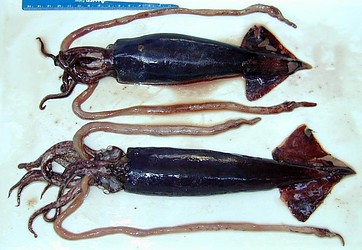
Figure. Gonatus cf. kamtschaticus from the stomach contents of sperm whales caught in the western North Pacific, fresh. Upper: dorsal view (ML=20cm), Lower: ventral view (ML=24cm).
Life History
Morphological changes with growth of G. middendorffi 6-60mm ML were reported by Kubodera and Okutani (1981). Juveniles of G. middendorffi, larger than 11 mm ML may be identified by the slender, muscular mantle, short arms and long tentacles with a stalk with 4 rows of numerous small suckers proximal to the tentacular club. Paralarvae smaller than 11mm ML are morphologically too close to those of Berryteuthis anonychus. Only the number of teeth on the radula make them distinguishable (5 rows for G. middendorffi, 7 rows for B. anonychus).

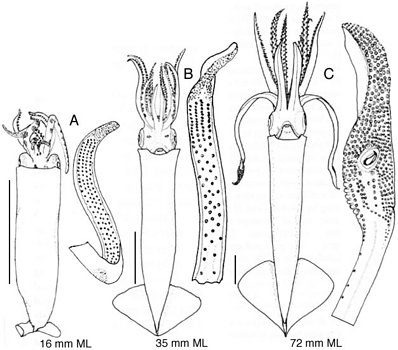
Figure. Morphological changes of G. middendorffi with growth. Ventral views of juvenile and immature specimens and oral surface of their tentacles. Drawings from Kubodera and Okutani, 1981.
Paralarvae also can be identified by the dorsal-head chromatophore pattern which is Type I,2 (three tear-shaped chromatophores on each side plus two additional chromatophore in the midline of the head) or Type I,1 since the anterior extra chromatophore was very faint in the large specimen examined, it could be absent in smaller paralarvae; the mantle has 16 dorsal chromatophores (Jorgensen, 2006)
Distribution
Juvenile and immature G. middendorffi are widely distributed in the western part of subarctic waters in the North Pacific including in the western Bering Sea, and a few have been recorded from the Gulf of Alaska. Nesis (1997) mentiond that the geographic range of this speceis (G. kamtschaticus in his paper) is of nerito-oceanic type or intermediate between truly oceanic and nerito-oceanic, because it is pelagic in habit but common in the "nearshore oceanic" zone not far from continental and island slopes and rare in the open ocean.
References
Jorgensen, E. M. 2007. Identification, distribution and relative abundance of paralarval gonatid squids (Cephalopoda: Oegopsida: Gonatidae)from the Gulf of Alaska, 2001-2003. Journ. Molluscan Studies, 73: 155-165.
Kubodera, T. and T. Okutani. 1981. Gonatus middendorffi, a new species of gonatid squid from the northern North Pacific, with notes on morphological changes with growth and distribution in immature stages (Cephalopoda, Oegopsida). Bull. Nat. Sci. Mus., Ser. A, 7: 7-27.
Kubodera, T. and T. Okutani. 1981. The systematics and identification of larval cephalopods from the northern North Pacific. Reserach Institute of North Pacific Fisheries, Special Volume: 131-159.
Nesis, K. N. 1997. Gonatid squids in the subarctic North Pacific: ecology, biogeography, niche diversity and rolein the ecosystem. Advance In Marine Biology, 32: 243-324.
Okutani, T., T. Kubodera and K. Jefferts. 1983. Diversity, distribution and ecology of gonatid squids in the subarctic Pacific: A review. Bull. Ocean Res. Inst., Univ. Tokyo, No. 26 (1):150-192.
Title Illustrations

| Scientific Name | Gonatus middendorffi |
|---|---|
| Reference | Kubodera, T. and T. Okutani. 1981. Gonatus middendorffi, a new species of gonatid squid from the northern North Pacific, with notes on morphological changes with growth and distribution in immature stages (Cephalopoda, Oegopsida). Bull. Nat. Sci. Mus., Ser. A, 7: 7-27. |
| View | Ventral |
| Size | 225 mm ML |
| Type | Holotype |
| Image Use |
 This media file is licensed under the Creative Commons Attribution-NonCommercial License - Version 3.0. This media file is licensed under the Creative Commons Attribution-NonCommercial License - Version 3.0.
|
| Copyright |
©
Tsunemi Kubodera

|
About This Page
Tsunemi Kubodera

National Science Museum, Tokyo, Japan
Correspondence regarding this page should be directed to Tsunemi Kubodera at
Kubodera@kahaku.go.jp
Page copyright © 2016 Tsunemi Kubodera
 Page: Tree of Life
Gonatus middendorffi .
Authored by
Tsunemi Kubodera.
The TEXT of this page is licensed under the
Creative Commons Attribution-NonCommercial License - Version 3.0. Note that images and other media
featured on this page are each governed by their own license, and they may or may not be available
for reuse. Click on an image or a media link to access the media data window, which provides the
relevant licensing information. For the general terms and conditions of ToL material reuse and
redistribution, please see the Tree of Life Copyright
Policies.
Page: Tree of Life
Gonatus middendorffi .
Authored by
Tsunemi Kubodera.
The TEXT of this page is licensed under the
Creative Commons Attribution-NonCommercial License - Version 3.0. Note that images and other media
featured on this page are each governed by their own license, and they may or may not be available
for reuse. Click on an image or a media link to access the media data window, which provides the
relevant licensing information. For the general terms and conditions of ToL material reuse and
redistribution, please see the Tree of Life Copyright
Policies.
- First online 31 May 2006
- Content changed 11 October 2015
Citing this page:
Kubodera, Tsunemi. 2015. Gonatus middendorffi . Version 11 October 2015. http://tolweb.org/Gonatus_middendorffi/19771/2015.10.11 in The Tree of Life Web Project, http://tolweb.org/






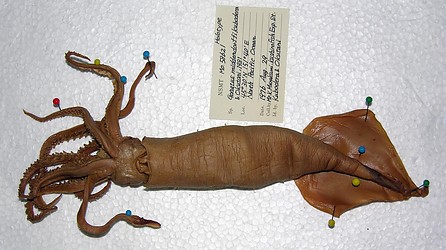



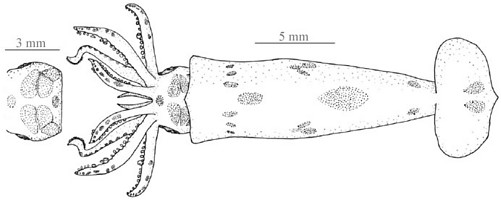
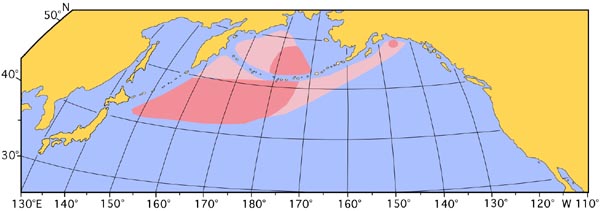



 Go to quick links
Go to quick search
Go to navigation for this section of the ToL site
Go to detailed links for the ToL site
Go to quick links
Go to quick search
Go to navigation for this section of the ToL site
Go to detailed links for the ToL site